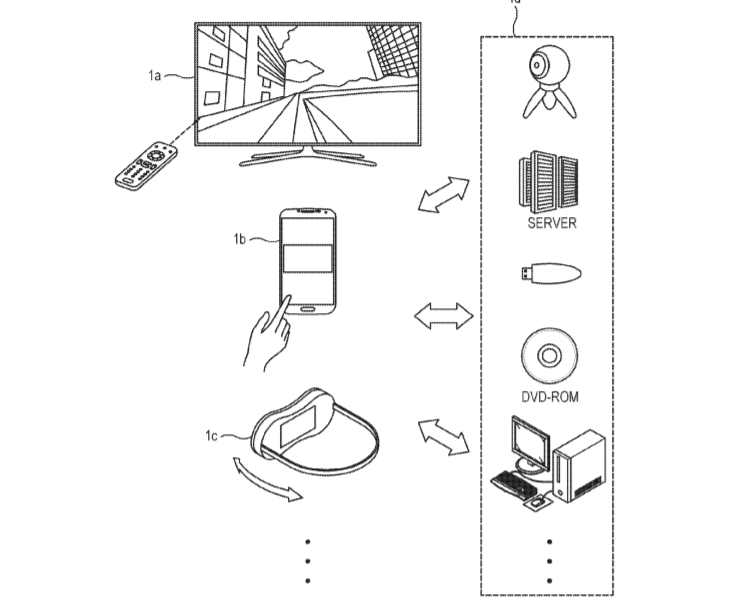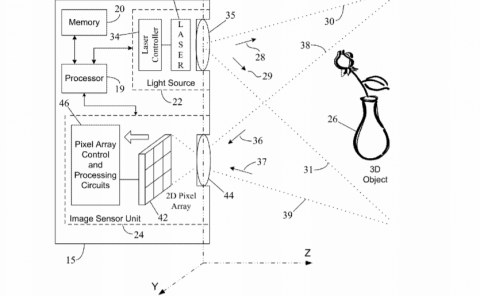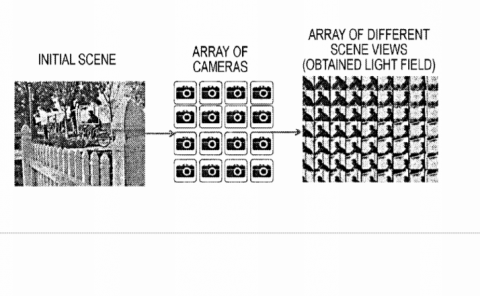Samsung Patent | Display Apparatus, Method of Controlling the Same, and Computer Program Product Thereof
Patent: Display Apparatus, Method of Controlling the Same, and Computer Program Product Thereof
Publication Number: 20190026005
Publication Date: 2019-01-24
Applicants: Samsung

Abstract
A display apparatus, a method of controlling the same, and a computer program product thereof are provided. The display apparatus includes a display configured to display an image; and a processor configured to determine output coordinates of a frame involved in a section, according to a plurality of sections of content including a plurality of frames reproducible for a predetermined period of time, and control the display to display a region of a frame corresponding to a viewpoint while moving the viewpoint along determined output coordinates, when determination of the output coordinates of at least one section among the plurality of sections is completed.
Background
The disclosure relates to a display apparatus and a method of controlling the same, and more particularly to a display apparatus, a method of controlling the same, and a computer program product thereof, in which a 360-degree image is automatically reproduced by calculating a moving path of a viewpoint.
Recently, various images have been provided through a display apparatus. For example, there is a 360-degree image. To this end, many cameras or a camera with a plurality of lenses may be used to take omnidirectional images. The display apparatus maps the taken images onto a virtual space and outputs a screen so that a user can feel as if s/he is in a real space and interacts with the screen.
The display apparatus moves a viewpoint on the output screen in response to a user’s input, or automatically determines a moving path of a viewpoint (hereinafter, the latter case will be referred to as automatic viewpoint reproduction or automatic path reproduction). In the automatic viewpoint reproduction, there are many ways of determining the moving path of the viewpoint. For example, the moving path of the viewpoint is determined based on a user’s region of interest. The region of interest is determined based on matters of a user’s interest. To determine the viewpoint based on the region of interest or the like specific reference, computations are required.
However, according to a related art, content has to be entirely subjected to the computations so as to be reproduced as an image. Therefore, when a large size of content is given or when a reference for determining the viewpoint is complicated, the quantity of computations increases and becomes a burden on performance, thereby causing a problem. Further, according to the related art, when the automatic viewpoint reproduction is stopped by a user’s input for manually moving a viewpoint and then resumed, the computations are performed again with regard to the next paths and become a burden on operations, thereby causing a problem.
However, the viewpoint may not move as desired by a user during the automatic viewpoint reproduction. As a result, a user may feel dizzy due to unintended change in the viewpoint, thereby causing a problem.
Further, according to the related art, in the case where the automatic viewpoint reproduction is stopped by a user’s input for manually moving a viewpoint and then resumed, there are no specific references for where the next paths will be. Therefore, in this case, there is a need of resuming the reproduction to be more convenient for a user.
Summary
Provided are a display apparatus, a method of controlling the same, and a computer program product thereof, in which a computation burden is reduced by decreasing the quantity of computation processed for automatic viewpoint reproduction.
Further, provided is a display apparatus, which can relieve dizziness a user may feel during automatic viewpoint reproduction, and a method of controlling the same.
Further still, provided are a display apparatus, which is convenient for a user to resume automatic viewpoint reproduction after manual viewpoint reproduction, and a method of controlling the same.
Additional aspects will be set forth in part in the description which follows and, in part, will be apparent from the description, or may be learned by practice of the presented embodiments.
In accordance with an aspect of the disclosure, there is provided a display apparatus comprising: a display; and a processor configured to map a frame of a content on a three-dimensional object, identify output coordinates corresponding to a viewpoint which changes according to a user input while the content is played back, and control the display to display a region of the frame mapped on the three-dimensional object based on the identified output coordinates, wherein the processor is further configured to identify first output coordinates of frames involved in a first section of the content; playback the first section of the content based on the identified first output coordinates; after the playback of the first section of the content is started, identify second output coordinates of frames involved in a second section of the content based on at least one of the first output coordinates, the second section following the first section; and playback the second section of the content based on the identified second output coordinates.
The processor is may be configured to identify the output coordinates so that the movement of the viewpoint between the frames decreases.
The processor is may be configured to replace second output coordinates with fourth output coordinates, the fourth output coordinates being relatively closer to a straight path between first output coordinates and third output coordinates than the second output coordinates, with regard to the first output coordinates, the second output coordinates and the third output coordinates determined in sequence.
The processor may be further configured to control the viewpoint to be kept for a determined time period while the viewpoint moves according to the identified output coordinates.
The processor may be further configured to control the viewpoint to move while decreasing at least one of a moving amount, a moving speed, and a moving acceleration of the viewpoint.
The processor may be further configured to control the viewpoint to move from first output coordinates to third output coordinates by skipping over second output coordinates, with regard to the first output coordinates, the second output coordinates, and the third output coordinates determined in sequence.
The processor may be configured to interpolate fourth output coordinates into a point on an adjusted path from the first output coordinates to the third output coordinates, and control the viewpoint to move from the first output coordinates to the second output coordinates via the fourth output coordinates.
The processor may be configured to control the viewpoint to move in accordance with a change in the output coordinates when the change in the output coordinates is greater than or equal to a lower limit, control the viewpoint to not move when the change in the output coordinates is lower than the lower limit.
The display apparatus may include a user input configured to receive a user’s input, wherein the processor may be further configured to, when the user’s input is received while the viewpoint is moving based on the output coordinates determined by a predetermined method, control the viewpoint to move based on output coordinates determined by the received user’s input.
The processor may be configured to determine output coordinates at a current viewpoint again by the predetermined method, and control movement of the viewpoint to be resumed, after moving the viewpoint based on the output coordinates determined by the user’s input.
The processor may be further configured to control movement of the viewpoint to be resumed based on output coordinates previously determined by the predetermined method at a current viewpoint, after moving the viewpoint based on the output coordinates determined by the user’s input.
The processor may be further configured to control movement of the viewpoint to be resumed based on output coordinates previously determined by the predetermined method by returning to the viewpoint at which the user’s input is received, after moving the viewpoint based on the output coordinates determined by the user’s input.
In accordance with an aspect of the disclosure, there is provided a method of controlling a display apparatus, the method including: mapping a frame of a content on a three-dimensional object; identifying output coordinates corresponding to a viewpoint which changes according to a user input while the content is played back; displaying a region of the frame mapped on the three-dimensional object based on the identified output coordinates; identifying first output coordinates of frames involved in a first section of the content; playing back the first section of the content based on the identified first output coordinates; after the playback of the first section of the content is started, identifying second output coordinates of frames involved in a second section of the content based on at least one of the first output coordinates, the second section following the first section; and playing back the second section of the content based on the identified second output coordinates.
The method may include identifying the output coordinates so that the movement of the viewpoint between the frames decreases.
The controlling of the viewpoint may include replacing second output coordinates with fourth output coordinates, the fourth output coordinates being relatively closer to a straight path between first output coordinates and third output coordinates than the second output coordinates, with regard to the first output coordinates, the second output coordinates and the third output coordinates determined in sequence.
The controlling of the viewpoint may include controlling the viewpoint to be kept for a predetermined section while the viewpoint moves.
The controlling of the viewpoint may include controlling the viewpoint to be kept for a determined time period while the viewpoint moves according to the identified output coordinates.
The controlling of the viewpoint may include controlling the viewpoint to move from first output coordinates to third output coordinates by skipping over second output coordinates, with regard to the first output coordinates, the second output coordinates, and the third output coordinates determined in sequence.
The controlling of the viewpoint may include interpolating fourth output coordinates into a point on an adjusted path from the first output coordinates to the third output coordinates, and controlling the viewpoint to move from the first output coordinates to the second output coordinates via the fourth output coordinates.
In accordance with an aspect of the disclosure, there is provided a non-transitory computer-readable recording medium having recorded thereon one or more instructions for performing operations for controlling a display apparatus, the operations comprising: mapping a frame of a content on a three-dimensional object; identifying output coordinates corresponding to a viewpoint which changes according to a user input while the content is played back; displaying a region of the frame mapped on the three-dimensional object based on the identified output coordinates; identifying first output coordinates of frames involved in a first section of the content; playing back the first section of the content based on the identified first output coordinates; after the playback of the first section of the content is started, identifying second output coordinates of frames involved in a second section of the content based on at least one of the first output coordinates, the second section following the first section; and playing back the second section of the content based on the identified second output coordinates.



